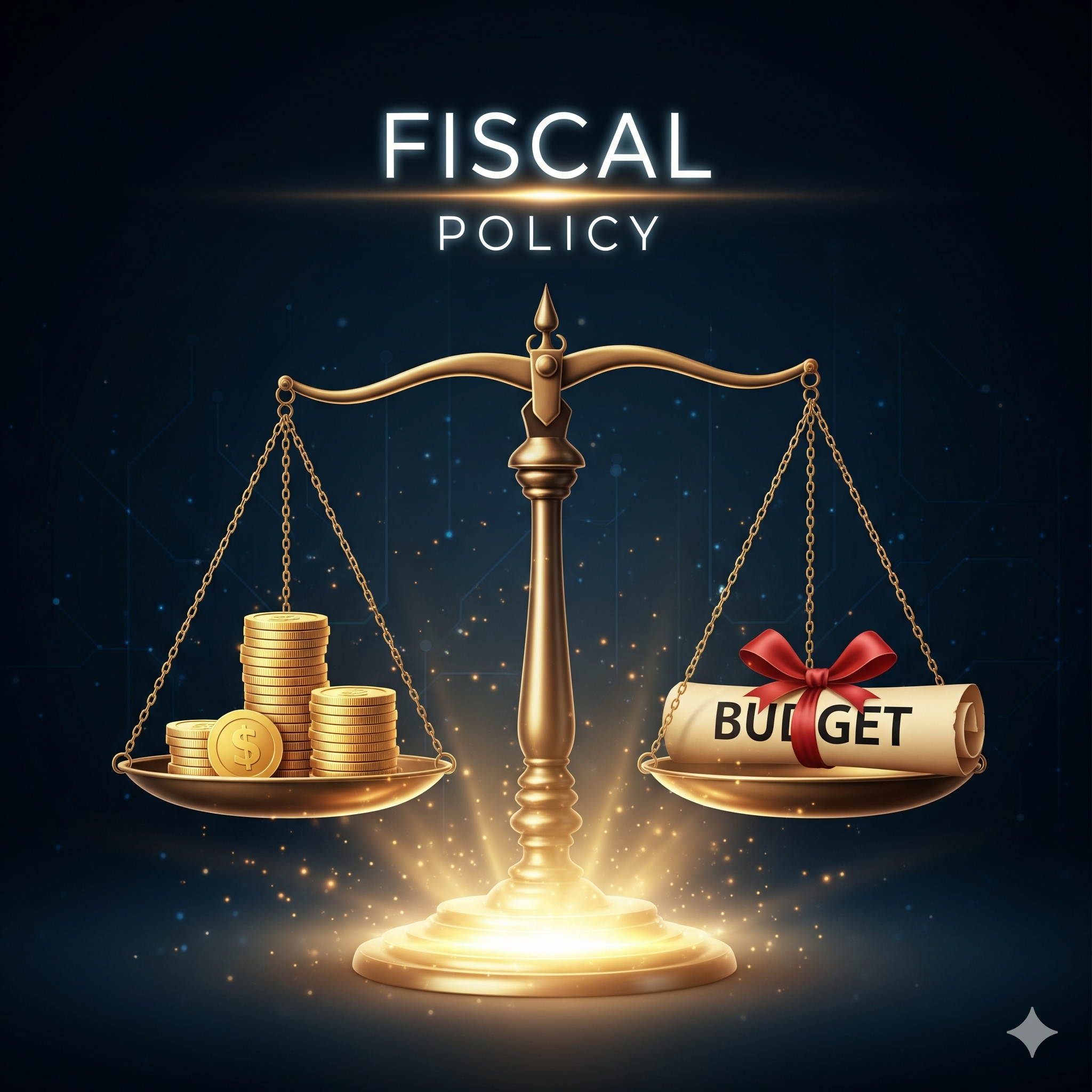Introduction
Every government in the world plays a significant role in the economic development of its nation. This role is carried out not only through laws, policies, and regulations but also through its financial decisions related to revenue and expenditure. The two main instruments of economic management are monetary policy and fiscal policy. While monetary policy is controlled by the central bank of a country, fiscal policy is designed and implemented by the government itself. Fiscal policy, therefore, becomes an essential mechanism for resource mobilization, redistribution of income, promoting stability, and ensuring long-term growth.
In the context of developing economies like India, fiscal policy has gained enormous importance as it serves as a tool for promoting investment, accelerating growth, and reducing inequalities. However, challenges such as fiscal imbalance and the need for deficit financing often arise in the implementation of fiscal policies. This article discusses in detail the meaning of fiscal policy, its objectives, fiscal imbalance, and the concept of deficit financing.
What is Fiscal Policy?
Fiscal policy refers to the use of government revenue and expenditure policies to influence the overall economy. In simpler terms, it is the method through which a government manages its budget, i.e., how much it collects in the form of taxes and how much it spends on development, defense, welfare, subsidies, infrastructure, and other activities.
The term “fiscal” is derived from the Latin word fiscus, which means treasury. Hence, fiscal policy essentially deals with government finances. It is the budgetary policy of the government that includes taxation, borrowing, spending, and managing public debt in order to achieve macroeconomic stability and development.
Economist J.M. Keynes highlighted the importance of fiscal policy, especially during times of recession and unemployment. He argued that government intervention through increased public expenditure and reduced taxation could help boost demand and stimulate economic activity.
In practice, fiscal policy operates through two main components:
- Revenue (mainly taxes and non-tax receipts like fees, profits of public sector enterprises, etc.)
- Expenditure (both developmental like education, health, infrastructure, and non-developmental like defense, administration, and subsidies).
Types of Fiscal Policy
Fiscal policy can be categorized into three main types based on its objective and use:
- Expansionary Fiscal Policy
- Adopted during periods of economic slowdown or recession.
- Government increases expenditure and reduces taxes to stimulate demand and investment.
- Objective: to create employment, enhance purchasing power, and revive growth.
- Contractionary Fiscal Policy
- Used during periods of inflation when the economy is overheated.
- Government reduces expenditure and increases taxes to control excessive demand and rising prices.
- Objective: to maintain stability and prevent the economy from spiraling into hyperinflation.
- Neutral Fiscal Policy
- Government expenditure is balanced with revenue collection.
- Neither expansionary nor contractionary, it simply maintains stability without major interventions.
Objectives of Fiscal Policy
Fiscal policy is not just a financial tool; it is a comprehensive instrument of economic development and welfare. The main objectives of fiscal policy are as follows:
1. Economic Growth and Development
One of the foremost objectives of fiscal policy is to promote economic growth by ensuring sufficient investment in infrastructure, industries, and agriculture. Government spending on development projects generates employment and raises income levels, thereby stimulating economic growth.
2. Price Stability
Price fluctuations can destabilize an economy. Inflation erodes purchasing power, while deflation discourages investment and production. Fiscal policy, through taxation and expenditure adjustments, helps maintain price stability by managing demand and supply in the economy.
3. Employment Generation
In countries with high unemployment, fiscal policy plays a crucial role in creating job opportunities. By increasing public investment in infrastructure, health, and education, governments can generate large-scale employment directly and indirectly.
4. Reduction of Inequalities
One of the objectives of fiscal policy is to reduce income and wealth disparities. This is achieved through progressive taxation (higher taxes on the rich) and redistributive expenditure (subsidies, social welfare schemes, and benefits for the poor).
5. Mobilization of Resources
Fiscal policy mobilizes resources from both internal and external sources. Taxes, loans, and public savings are mobilized to finance development projects, while external borrowings and foreign aid are used to supplement domestic resources.
6. Promoting Investment
Through incentives like tax holidays, subsidies, and reduced corporate taxes, fiscal policy encourages private investment. Similarly, public investment in infrastructure creates a favorable environment for industrial and agricultural growth.
7. Balanced Regional Development
Governments use fiscal policy to reduce regional disparities by investing in backward areas, providing tax concessions, and subsidizing industries located in less developed regions.
8. Ensuring Economic Stability
Fiscal policy aims to prevent economic fluctuations by managing demand and supply. By controlling inflation, unemployment, and balance of payments crises, fiscal policy ensures overall stability in the economy.
9. Encouraging Exports and Reducing Imports
Through tax rebates, subsidies, and export incentives, fiscal policy promotes exports while discouraging unnecessary imports, thus improving the balance of trade.
Fiscal Imbalance
While fiscal policy aims to maintain a balance between government revenue and expenditure, in practice, imbalances often occur. Fiscal imbalance refers to a situation where government expenditure exceeds its revenue, leading to budget deficits and rising debt.
Types of Fiscal Imbalances
- Vertical Fiscal Imbalance
- Occurs when there is a mismatch between the revenue powers and expenditure responsibilities of different levels of government (central and state governments).
- For example, in India, the central government collects more revenue through taxes, while states have higher expenditure responsibilities, leading to imbalances.
- Occurs when there is a mismatch between the revenue powers and expenditure responsibilities of different levels of government (central and state governments).
- Horizontal Fiscal Imbalance
- Arises due to unequal distribution of resources among states or regions.
- Some states may be more developed and capable of raising higher revenue, while others remain financially weaker, creating horizontal disparities.
- Budgetary Imbalance
- A direct imbalance between revenue and expenditure in a government’s budget.
- When expenditure is greater than revenue, fiscal deficit arises.
- Macroeconomic Fiscal Imbalance
- A broad imbalance where persistent deficits lead to rising debt, inflationary pressure, and loss of investor confidence.
Causes of Fiscal Imbalance
- Excessive government expenditure on subsidies, defense, and administration.
- Low tax collection due to evasion, exemptions, and narrow tax base.
- Rising debt servicing costs.
- Populist schemes without adequate revenue support.
- Regional disparities in resource mobilization.
Consequences of Fiscal Imbalance
- High fiscal deficit leading to increased borrowing.
- Inflation due to excessive government spending.
- Reduced funds available for development activities.
- Growing debt burden on future generations.
- Loss of economic stability and investor confidence.
Deficit Financing
Deficit financing is one of the methods adopted by governments to meet the fiscal imbalance when expenditure exceeds revenue. It is a practice where the government borrows money or creates new money to cover the budgetary gap.
Definition
Deficit financing refers to the practice of financing budgetary deficits through borrowing from the public, external sources, or by printing new currency. In India, the term is generally associated with government borrowing from the Reserve Bank of India (RBI), which issues new money to meet the deficit.
Methods of Deficit Financing
- Borrowing from the Public
- Through bonds, securities, and savings schemes.
- Through bonds, securities, and savings schemes.
- Borrowing from Banks
- Commercial banks and financial institutions lend to the government.
- Commercial banks and financial institutions lend to the government.
- External Borrowing
- Loans from foreign governments, World Bank, IMF, etc.
- Loans from foreign governments, World Bank, IMF, etc.
- Monetization of Deficit (Printing of Money)
- RBI prints new currency notes to finance the deficit.
Objectives of Deficit Financing
- To stimulate economic growth in developing countries.
- To finance large-scale development projects like roads, dams, power plants, etc.
- To create employment opportunities.
- To boost investment and increase aggregate demand.
Merits of Deficit Financing
- Provides necessary funds for development when savings are low.
- Generates employment and increases national income.
- Useful during economic depression to revive demand.
- Helps in mobilizing idle resources.
Demerits of Deficit Financing
- Excessive deficit financing may lead to inflation.
- Rising debt burden on government finances.
- Misuse for populist schemes rather than productive investment.
- Risk of dependency on deficit financing, undermining fiscal discipline.
Fiscal Policy, Fiscal Imbalance, and Deficit Financing in India
India, as a developing country, faces continuous challenges in balancing growth and stability. Fiscal policy in India has aimed at accelerating development, reducing poverty, and ensuring equitable distribution of resources. However, fiscal imbalances have frequently emerged due to high expenditure on subsidies, welfare schemes, and defense, along with limited revenue mobilization.
To bridge this gap, India has often relied on deficit financing, especially in the post-independence period when large-scale investments were required for industrialization. While it contributed to growth, it also led to inflationary pressures and rising debt, prompting the government to adopt measures such as the Fiscal Responsibility and Budget Management (FRBM) Act to maintain fiscal discipline.
Conclusion
Fiscal policy is one of the most vital instruments of economic management in any country. By carefully balancing taxation and expenditure, governments can stimulate growth, ensure stability, generate employment, and reduce inequalities. However, challenges like fiscal imbalance and the need for deficit financing remain persistent, especially in developing economies.
While deficit financing may be necessary to support development and growth, excessive reliance on it can lead to inflation, debt burden, and instability. Hence, governments must adopt a balanced approach, ensuring that fiscal policy promotes growth without compromising stability. In the case of India, fiscal discipline, coupled with innovative resource mobilization and efficient expenditure management, remains the key to sustainable economic development.




